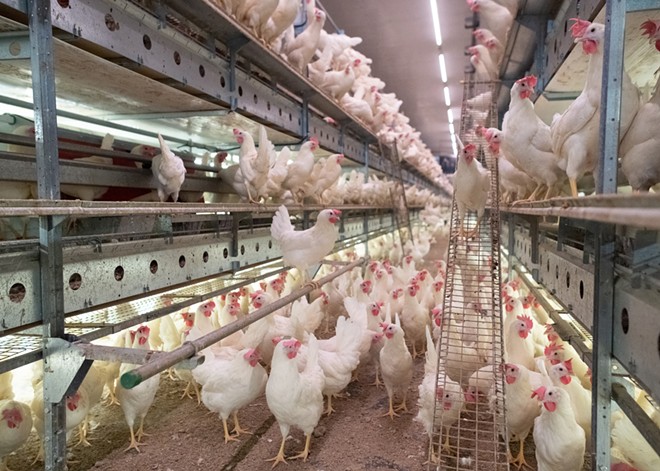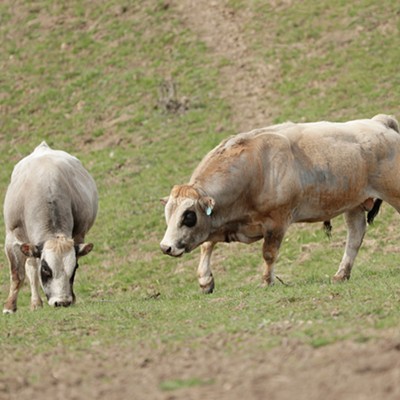On a refrigerator door at My Fresh Basket, an eye-level green flier with an illustration of three fluffy, yellow chicks blocks the view of the egg cartons.
"Senate Bill 1019," it reads. "Signed August 2019, this senate bill bans the use of cage confinement for egg-laying hens and the sale of egg products from out-of-state operations not meeting cage-free standards."
It ended with an explanation — or warning — that the law would "significantly impact current egg pricing."
In simpler language, Washington state passed a law in 2019 that all eggs sold in Washington, including those produced in other states like Oregon, must be cage-free. The law went into effect on Jan. 1 and, if you believe the flier, is the reason egg prices are rising in Spokane.
It's not just grocers. Amber Gunn, an analyst with the Mountain State Policy Center, blamed the legislation for "skyrocketing egg prices." Seattle's KIRO 7 News ran a piece saying the law "takes toll on bakeries." And OregonLive reported that "more ethical eggs can mean higher prices."
But is it that simple? And what does "cage-free" mean, anyway?
The new law may increase egg prices, especially at first. But the cage-free law isn't the only factor, and maybe not the most important. There's inflation and increased costs for feed, labor and materials. But the biggest impact on egg prices is a mysterious strain of the avian flu lurking in wild bird populations that's wreaking occasional havoc on commercial egg operations.
But so far, there are no fliers about bird flu on grocery refrigerator doors. There are, however, some customers who are happy to pay $4 a dozen so the birds get a better life, and others who wonder what the improvements are, and if they're worth shelling out for.
THE FUTURE IS CAGE-FREE
In 2021, Willamette Egg Farms hen houses in Moses Lake started making the transition to cage-free. After Willamette was bought by Versova, a management team out of the Midwest, it started tearing down stacked battery cages and building cage-free aviaries instead.
Imagine a big barn with an open dirt floor in the middle. Three or four levels of perching space are stacked either like shelves or like stadium seating along the walls. Designated nesting boxes are in darkened, private spaces.
"From my seat, I believe that cage-free egg production seems like a very good system," says Matthew Dean, chief financial officer of Versova. "It seems like a very good outcome for the birds themselves since they can exhibit those normal, natural behaviors. And I guess it feels right to me."
In 2018, about 15% of all commercial hens lived in cage-free housing. By July 2023, that percentage jumped to upwards of 40%, thanks to different states passing bans on conventional production.
The new cage-free law in Washington requires all eggs sold in the state to be raised without cages and with at least a square foot of floor space per bird. Both the Humane Society of the United States and various egg producers in Washington collaborated to propose the new legislation.
"What we found from working with producers is that they really want market certainty," says Kate Brindle, a program manager at the national Humane Society. Animal welfare activists and a growing number of consumers have raised concerns about conventional egg production.
"The birds can't even spread their wings," Brindle says. "Each bird is given less space than the size of an iPad on which to live her entire life. They're denied almost everything that's natural to them."
The public is putting pressure on egg producers and major egg buyers, she says, because "when people learn about that, it's not the sort of cruelty that they want to support."
"The future is cage-free," Brindle says. "For example, McDonald's just reached 100% cage-free. The producers see that and they realize that that's the way the market is going."
A square foot isn't a whole lot of space — it's about the size of a page in the Inlander. Plus, when birds are close together without the protection of cages, some worry that chicken-on-chicken violence can get out of hand.
"In terms of the chicken's quality of life, that was my concern," says Rep. Mary Dye, R-Pomeroy, who voted against the initial House bill in 2019. "Chickens have a pecking order. In a coop of chickens that are at-large, if one of them has a little red spot on them, man, the chickens will pick and pick and pick and pick. There's a lot of loss and death in a chicken coop that is left in its social order. That's stressful on the birds."
Cage-free production does require more employee vigilance, says Versova's Dean. Vulnerable birds need to be separated. Plus, young hens need to be trained to lay eggs in the proper nesting boxes and not on the floor. Farms need additional staff to monitor the aviaries more closely.
But a square foot is enough space for the hens to spread their wings, he says, and chickens like to be close together as a flock. Hens will often huddle close together even if they have room to spread out.
"It's kind of fun to be in the barn, because some of the birds clearly have different behaviors," he says. "Some of them are maybe a little lazy or want to be on the ground or low. And some of them are more aggressive and more adventurous. So it's kind of fun to just watch the different personalities play on the barns."
WIGGLE ROOM
When eggs were an average $0.88 per dozen in 1980, or even $1.45 in February 2020, egg producers could turn a profit by stacking as many birds as possible in one building to keep overhead low. Now, new laws mean new construction and fewer birds per building.
"Fewer birds in the barn means fewer eggs to spread our cost around," Dean says. "The increased costs for the producer we pass on to our customers. I don't think the cost difference has anything to do with any sort of greenwashing or anything like that. It really is our increased production costs."
California passed Proposition 12 in 2018, which required all eggs sold in the state to be cage-free by 2021. According to market research, there was an initial uptick in prices as egg producers constructed new cage-free housing systems. But when these outliers from the transitional year were removed, a dozen eggs were about $0.08 more than before the legislation was enacted.
Brindle assumes the same thing will happen in Washington — some initial price increase during this transition year, then a leveling out to prices similar to 2022 or 2023.
That may or may not be a comfort, considering egg prices in recent years have been steadily increasing and occasionally spiking.
"The big thing about price increases in agricultural products, [is that] there's always a dynamic," Dye says. "You can't just say one thing is the sole contributor to the increase."
Eggs are a commodity, she says, and very sensitive to changes in supply and demand.
There are about as many laying hens as there are people in the United States. Each hen can lay an average of 300 eggs a year, according to United Egg Producers. That's up from 264 eggs a year in 2002, thanks to improved nutrition, genetics and flock management.
But the demand for eggs in the U.S. is also rising. In 2000, the average American ate about 250 eggs a year, according to the data-gathering website, Statista. That average is projected to reach almost 285 eggs this year.
So, if there's about one hen per person in America, laying about as many eggs a year as that person eats, there's not much wiggle room. Unlike other agriculture commodities, the U.S. relies mostly on domestic egg production, usually importing about 1% of the eggs Americans eat each year.
If the consumer demand for eggs stays consistent but something interrupts egg supply, price is very sensitive to that change. One of the most persistent interruptions to American egg supply is a new, strange strain of avian flu.
"We've been going through a major disease issue in the U.S. for the last two years with bird flu," says Dean. "The cage-free market itself is a little smaller than the conventional market, so when bird flu does hit the cage-free market, it might impact it more. There's multiple issues at play when we talk about egg prices."
Versova, which manages farms that are both cage-free and conventional, had two farms "go positive" for bird flu at the end of last year. They had to kill 4 million birds, as required by government regulations, to try to contain the disease, which is proving harder to eliminate than in the past.
"The last time the U.S. got hit with bird flu was in 2015," Dean says. "That year, it came in the spring and was very impactful. But then once we got warmer weather, it kind of just went away and never came back. This particular strain of bird flu, for whatever reason, lingers in the environment longer. It does not seem to be consistent. It's remaining very, very prevalent in the wild bird population, which is the most concerning thing."
Scientists and veterinarians around the world are trying to figure out why this strain of bird flu is so much more resilient than previous strains, Dean says. Until it disappears, the cost of all eggs, cage-free or not, will continue to react.
"From my seat, the vast majority of the pricing volatility you're seeing is not because of inflation or any other issues," Dean says. "It's bird flu purely impacting supply [while] consumer demand remains strong." ♦






















